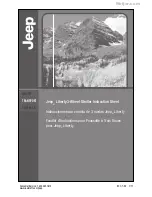
Instruction Manual
D200124X012
2500 and 2503 Controllers/Transmitters
June 2017
32
Table 7. Troubleshooting Chart for Fisher 2500 Controller/Transmitters (continued)
Fault
Possible Cause
Check
Correction
2. Controller/transmitter
controlling off set point or switching
point.
2.1 Supply pressure not set
correctly.
Make sure regulator supply pressure
is set correctly. Make sure regulator
IN supply pressure is within limits.
Reset the supply regulator pressure.
If the condition occurs again, rebuild
or replace regulator. Provide a
regulator input pressure within
regulator limits.
2.2 Leak in the
controller/transmitter loop.
Use soap and water to check for
internal and external leaks.
Replace or repair leaking parts as
necessary.
2.3 Leaking displacer.
Ensure the displacer is not filling
with process fluid.
Refer to sensor maintenance
procedures in the appropriate
sensor instruction manual.
2.4 Flapper adjustment.
Ensure the flapper is not loose on
the torque tube shaft and is
centered on the nozzle.
Replace or tighten flapper assembly
as necessary and/or center flapper
on nozzle.
2.5 Process variable changed.
Ensure the process variable has not
changed from original calibration
settings, or displacer not designed
for specific gravity of process.
Change process variable back to
original specification or recalibrate.
If necessary, provide replacement
displacer of correct size and
recalibrate.
3. Controller/transmitter cannot
attain full output range.
3.1 Supply pressure not set
correctly.
Make sure supply pressure is set
correctly. Make sure regulator IN
supply pressure is within limits.
Reset the regulator pressure. If
problem reoccurs, replace or rebuild
the regulator. Ensure regulator IN
supply pressure is within limits at all
operating levels.
3.2 Flapper adjustment.
Ensure the flapper is not loose on
the torque tube shaft and is
centered on the nozzle.
Replace or tighten flapper assembly
as necessary and/or center flapper
on nozzle.
3.3 Process variable changed.
Ensure the process variable has not
changed from original calibration
settings, or from displacers
designed specific gravity.
Change process variable back to
original specification or recalibrate.
If necessary, provide replacement
displacer of correct size and
recalibrate.
3.4 Relay malfunction
Check for relay malfunction by using
the testing relay deadband
procedure.
Depress plunger to clean out the
fixed restriction. Replace relay using
the procedure in the Maintenance
section.
3.5 Leak in the
controller/transmitter loop.
Use soap and water to check for
internal and external leaks.
Replace or repair leaking parts as
necessary.
4. Controller/transmitter remains
at full or zero output pressure.
4.1 Supply or output pressure
gauge malfunction.
Ensure the pressure gauges are
registering correctly.
Replace pressure gauges. Use
corrective action given in section 3
of this table.
4.2 Flapper adjustment.
Ensure the flapper is not loose on
the torque tube shaft and is
centered on the nozzle.
Replace or tighten flapper assembly
as necessary and/or center flapper
on nozzle.
Removing Controller/Transmitter from Sensor
WARNING
To avoid injury in the following steps, turn off the supply pressure and carefully release any pressure trapped in the
controller/transmitter before breaking any pressure connection. Provide a bypass for the control device if continuous
operation is required during maintenance.
1. Disconnect the supply and output pressure tubing from the controller or transmitter. For a controller/transmitter
with an indicator, remove the pointer assembly by referring to the Replacing the Bourdon Tube section.
tube rotary shaft.









































